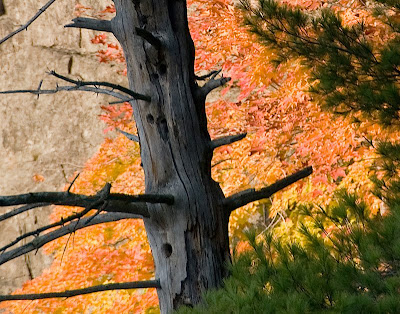The number 3 is one of the major standards for composition and design elements. In many photographs, 3 similar items will form a triangle when connecting the objects together and this is used to keep the viewer’s gaze moving around the photograph as we go from one item to the next.
In fact there is even a special name for a 3-image photograph or 3-panel painting which is a triptych. But what is when you want to include 4 items as in my 4-image frame below?
 The above image framed would be about 5 feet tall and 20 in wide.
The above image framed would be about 5 feet tall and 20 in wide.
On the Canadian Thanksgiving weekend when I took the images for the article The Many Colours of Fall I also took the images used to form the picture frame above.
After I took the image of the 2 people silhouetted against the bright fall foliage I turned sideways and saw this old dead tree, which formed a transition between the green pine trees and the vibrant foliage on the rock face. I did not have any special idea at that time. I only knew that the textures of the dead tree and colours looked great and I decided to take 4 images as I moved from the pond reflection upwards.

This is a close-up section of the 2nd from the top panel to show the great detail in the dead tree.
Each image I composed was a stand-alone image as I figured that one of these would probably turn out to be a real keeper.
It wasn’t until I got home that I realized that combined together, they just might form an interesting multi-image photograph. When combined together in a vertical pattern set the trees do not line up in a standard tree pattern.
The location is more than 100 miles away and with fall foliage just one day can make a great difference in the landscape, let alone the lighting conditions. There was just no way to go back and re-shoot.
There is some advantage in not having perfect alignment as it does compel the viewer to spend a little longer on each image as they move up or down. It also, for a brief moment, causes the viewer to wonder if each image is from the same spot.
This may be a good thing, as they might spend a little longer time viewing and thereby pondering what meaning you are trying to convey, if any.
But I would like the option to see how other alignments work, without having, in my case, to crop the format.
I did try a 4 Horizontal arrangement as shown below.
 Then a 3 image horizontal arrangement.
Then a 3 image horizontal arrangement.
With the set of images I prefer the 3 set better for the horizontal version.
I will print and mat the 4 vertical set and see how this looks before I get a frame made. Sometimes the only way to really understand a photograph is to print and then give yourself time to contemplate the result.
Niels Henriksen



4 comments:
I can't find any argument for or against 4 photos vs. 3 in a composition, but I think your strongest arrangement was the horizontal triptych. One image in the group of 4 has the tree leaning in the opposite direction, which -- to me -- is very jarring to the viewer and destroys the rhythm of the composition.
A very good point Dave.
Sometimes when you are experimenting with format you miss the obvious as you are too focused on the original vision and not thinking about new compositions that may open up.
This does get me thinking that in some situations, when you have multiple images, the correct placement of a contradiction may work.
Niels
It's terribly conventional I know, but I do prefer the tryptchs. I like very much the horizontal one, and I think I would also like the vertical arrangement minus the bottom frame. The fact that the trunks don't line up in this one makes it far more interesting for me. I admire your creativity in putting the images together—great idea.
Niels, I should have sent you this note right away, but I got distracted and forgot. If you check my blog (November 5), you will see you are on my list of recipients for the Kreativ Blogger Award. Enjoy!
Post a Comment